Wafer-Scale Emission Energy Modulation of Indium Flushed Quantum Dots
Abstract
:1. Introduction
2. Methods
3. Results
4. Conclusions
Author Contributions
Funding
Data Availability Statement
Conflicts of Interest
Appendix A
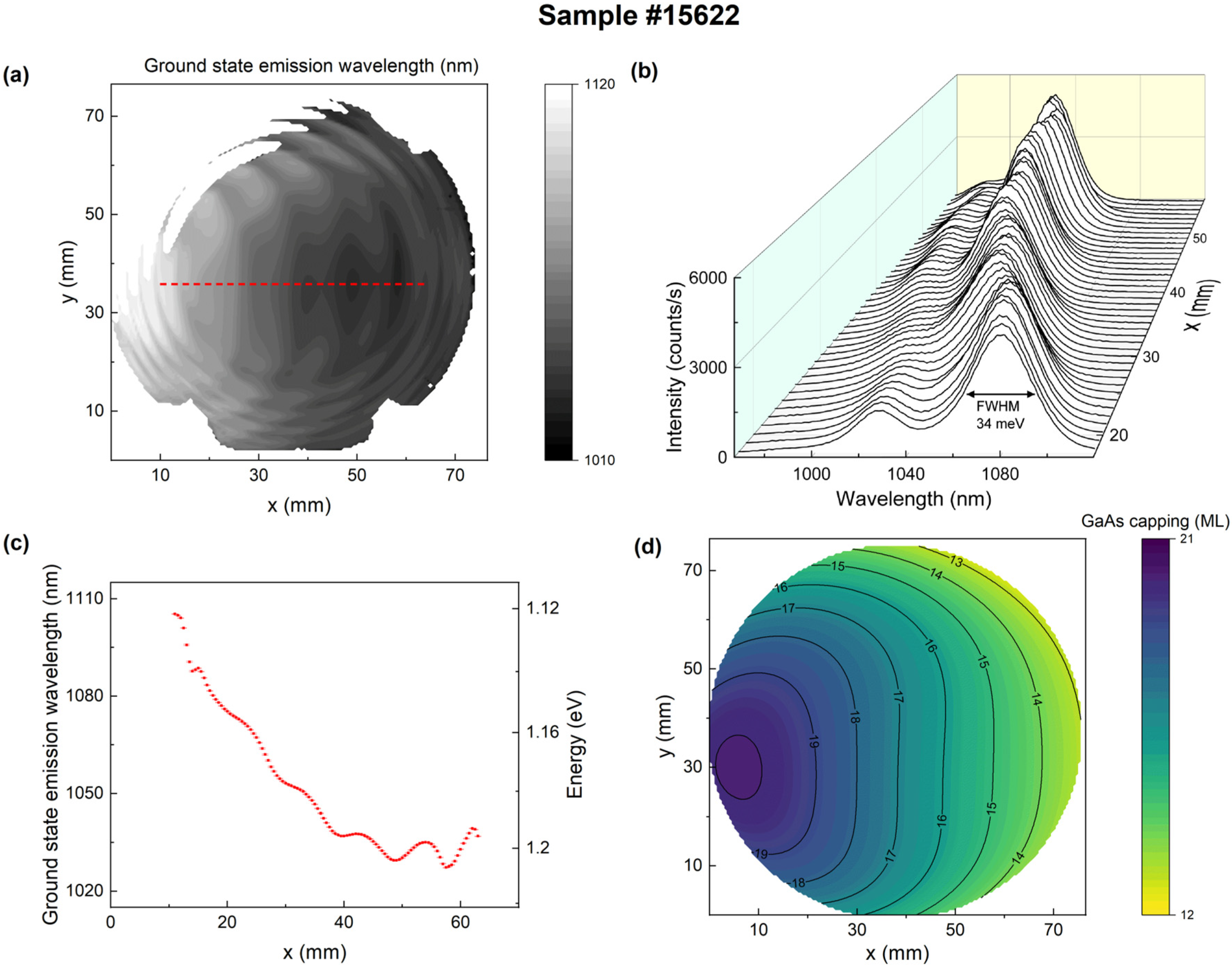
References
- Tomm, N.; Javadi, A.; Antoniadis, N.O.; Najer, D.; Löbl, M.C.; Korsch, A.R.; Schott, R.; Valentin, S.R.; Wieck, A.D.; Ludwig, A.; et al. A bright and fast source of coherent single photons. Nat. Nanotechnol. 2021, 16, 399–403. [Google Scholar] [CrossRef] [PubMed]
- The Nobel Prize in Chemistry 2023. NobelPrize.org. Nobel Prize Outreach AB 2023. Mon. 16 October 2023. Available online: https://www.nobelprize.org/prizes/chemistry/2023/summary/ (accessed on 13th October 2023).
- Kuhlmann, A.V.; Houel, J.; Ludwig, A.; Greuter, L.; Reuter, D.; Wieck, A.D.; Poggio, M.; Warburton, R.J. Charge noise and spin noise in a semiconductor quantum device. Nat. Phys. 2013, 9, 570–575. [Google Scholar] [CrossRef]
- Shchekin, O.B.; Deppe, D.G. 1.3 μm InAs quantum dot laser with To=161 K from 0 to 80 °C. Appl. Phys. Lett. 2002, 80, 3277–3279. [Google Scholar] [CrossRef]
- Newell, T.C.; Bossert, D.J.; Stintz, A.; Fuchs, B.; Malloy, K.J.; Lester, L.F. Gain and linewidth enhancement factor in InAs quantum-dot laser diodes. IEEE Photonics Technol. Lett. 1999, 11, 1527–1529. [Google Scholar] [CrossRef]
- Alves Machado Filho, M.; Hsiao, C.-L.; Dos Santos, R.B.; Hultman, L.; Birch, J.; Gueorguiev, G.K. Self-Induced Core-Shell InAlN Nanorods: Formation and Stability Unraveled by Ab Initio Simulations. ACS Nanosci. Au 2023, 3, 84–93. [Google Scholar] [CrossRef] [PubMed]
- Lundgren, C.; Kakanakova-Georgieva, A.; Gueorguiev, G.K. A perspective on thermal stability and mechanical properties of 2D Indium Bismide from ab initio molecular dynamics. Nanotechnology 2022, 33, 335706. [Google Scholar] [CrossRef]
- Babin, H.G.; Ritzmann, J.; Bart, N.; Schmidt, M.; Kruck, T.; Zhai, L.; Löbl, M.C.; Nguyen, G.N.; Spinnler, C.; Ranasinghe, L.; et al. Charge Tunable GaAs Quantum Dots in a Photonic n-i-p Diode. Nanomaterials 2021, 11, 2703. [Google Scholar] [CrossRef] [PubMed]
- Babin, H.-G.; Bart, N.; Schmidt, M.; Spitzer, N.; Wieck, A.D.; Ludwig, A. Full wafer property control of local droplet etched GaAs quantum dots. J. Cryst. Growth 2022, 591, 126713. [Google Scholar] [CrossRef]
- Heyn, C.; Stemmann, A.; Hansen, W. Dynamics of self-assembled droplet etching. Appl. Phys. Lett. 2009, 95, 173110. [Google Scholar] [CrossRef]
- Leonard, D.; Krishnamurthy, M.; Reaves, C.M.; Denbaars, S.P.; Petroff, P.M. Direct formation of quantum-sized dots from uniform coherent islands of InGaAs on GaAs surfaces. Appl. Phys. Lett. 1993, 63, 3203–3205. [Google Scholar] [CrossRef]
- Passow, T.; Li, S.; Feinäugle, P.; Vallaitis, T.; Leuthold, J.; Litvinov, D.; Gerthsen, D.; Hetterich, M. Systematic investigation into the influence of growth conditions on InAs/GaAs quantum dot properties. J. Appl. Phys. 2007, 102, 073511. [Google Scholar] [CrossRef]
- Rosenauer, A.; Gerthsen, D.; van Dyck, D.; Arzberger, M.; Böhm, G.; Abstreiter, G. Quantification of segregation and mass transport in InxGa1−xAs/GaAs Stranski-Krastanow layers. Phys. Rev. B 2001, 64, 245334. [Google Scholar] [CrossRef]
- Haffouz, S.; Raymond, S.; Lu, Z.G.; Barrios, P.J.; Roy-Guay, D.; Wu, X.; Liu, J.R.; Poitras, D.; Wasilewski, Z.R. Growth and fabrication of quantum dots superluminescent diodes using the indium-flush technique: A new approach in controlling the bandwidth. J. Cryst. Growth 2009, 311, 1803–1806. [Google Scholar] [CrossRef]
- Hino, Y.; Ozaki, N.; Ohkouchi, S.; Ikeda, N.; Sugimoto, Y. Growth of InAs/GaAs quantum dots with central emission wavelength of 1.05 μm using In-flush technique for broadband near-infrared light source. J. Cryst. Growth 2013, 378, 501–505. [Google Scholar] [CrossRef]
- Fafard, S.; Allen, C.N. Intermixing in quantum-dot ensembles with sharp adjustable shells. Appl. Phys. Lett. 1999, 75, 2374–2376. [Google Scholar] [CrossRef]
- Perret, N.; Morris, D.; Franchomme-Fossé, L.; Côté, R.; Fafard, S.; Aimez, V.; Beauvais, J. Origin of the inhomogenous broadening and alloy intermixing in InAs/GaAs self-assembled quantum dots. Phys. Rev. B 2000, 62, 5092–5099. [Google Scholar] [CrossRef]
- Lipinski, M.O.; Schuler, H.; Schmidt, O.G.; Eberl, K.; Jin-Phillipp, N.Y. Strain-induced material intermixing of InAs quantum dots in GaAs. Appl. Phys. Lett. 2000, 77, 1789–1791. [Google Scholar] [CrossRef]
- Wasilewski, Z.R.; Fafard, S.; McCaffrey, J.P. Size and shape engineering of vertically stacked self-assembled quantum dots. J. Cryst. Growth 1999, 201–202, 1131–1135. [Google Scholar] [CrossRef]
- Fafard, S.; Wasilewski, Z.R.; Allen, C.N.; Picard, D.; Spanner, M.; McCaffrey, J.P.; Piva, P.G. Manipulating the energy levels of semiconductor quantum dots. Phys. Rev. B 1999, 59, 15368–15373. [Google Scholar] [CrossRef]
- Fafard, S.; Wasilewski, Z.R.; Allen, C.N.; Hinzer, K.; McCaffrey, J.P.; Feng, Y. Lasing in quantum-dot ensembles with sharp adjustable electronic shells. Appl. Phys. Lett. 1999, 75, 986–988. [Google Scholar] [CrossRef]
- Molas, M.; Gołasa, K.; Kuldová, K.; Borysiuk, J.; Babiński, A.; Lapointe, J.; Wasilewski, Z.R. The effect of In-flush on the optical anisotropy of InAs/GaAs quantum dots. J. Appl. Phys. 2012, 111, 33510. [Google Scholar] [CrossRef]
- Keizer, J.G.; Clark, E.C.; Bichler, M.; Abstreiter, G.; Finley, J.J.; Koenraad, P.M. An atomically resolved study of InGaAs quantum dot layers grown with an indium flush step. Nanotechnology 2010, 21, 215705. [Google Scholar] [CrossRef]
- Wang, L.; Rastelli, A.; Schmidt, O.G. Structural and optical properties of In(Ga)As/GaAs quantum dots treated by partial capping and annealing. J. Appl. Phys. 2006, 100, 064313. [Google Scholar] [CrossRef]
- Kumagai, N.; Ohkouchi, S.; Nakagawa, S.; Nomura, M.; Ota, Y.; Shirane, M.; Igarashi, Y.; Yorozu, S.; Iwamoto, S.; Arakawa, Y. Suppression of indefinite peaks in InAs/GaAs quantum dot spectrum by low temperature capping in the indium-flush method. Phys. E Low-Dimens. Syst. Nanostructures 2010, 42, 2753–2756. [Google Scholar] [CrossRef]
- Costantini, G.; Rastelli, A.; Manzano, C.; Acosta-Diaz, P.; Songmuang, R.; Katsaros, G.; Schmidt, O.G.; Kern, K. Interplay between thermodynamics and kinetics in the capping of InAs/GaAs(001) quantum dots. Phys. Rev. Lett. 2006, 96, 226106. [Google Scholar] [CrossRef]
- Harris, J.J.; Joyce, B.A.; Dobson, P.J. Oscillations in the surface structure of Sn-doped GaAs during growth by MBE. Surf. Sci. Lett. 1981, 103, L90–L96. [Google Scholar] [CrossRef]
- Neave, J.H.; Joyce, B.A.; Dobson, P.J.; Norton, N. Dynamics of film growth of GaAs by MBE from Rheed observations. Appl. Phys. A 1983, 31, 1–8. [Google Scholar] [CrossRef]
- Bart, N.; Dangel, C.; Zajac, P.; Spitzer, N.; Ritzmann, J.; Schmidt, M.; Babin, H.G.; Schott, R.; Valentin, S.R.; Scholz, S.; et al. Wafer-scale epitaxial modulation of quantum dot density. Nat. Commun. 2022, 13, 1633. [Google Scholar] [CrossRef]
- Leonard, D.; Pond, K.; Petroff, P.M. Critical layer thickness for self-assembled InAs islands on GaAs. Phys. Rev. B 1994, 50, 11687–11692. [Google Scholar] [CrossRef]
- Joyce, P.B.; Krzyzewski, T.J.; Bell, G.R.; Jones, T.S. Surface morphology evolution during the overgrowth of large InAs–GaAs quantum dots. Appl. Phys. Lett. 2001, 79, 3615–3617. [Google Scholar] [CrossRef]
- Ulloa, J.M.; Koenraad, P.M.; Gapihan, E.; Létoublon, A.; Bertru, N. Double capping of molecular beam epitaxy grown InAs/InP quantum dots studied by cross-sectional scanning tunneling microscopy. Appl. Phys. Lett. 2007, 91, 073106. [Google Scholar] [CrossRef]
- Kurzmann, A.; Ludwig, A.; Wieck, A.D.; Lorke, A.; Geller, M. Auger Recombination in Self-Assembled Quantum Dots: Quenching and Broadening of the Charged Exciton Transition. Nano Lett. 2016, 16, 3367–3372. [Google Scholar] [CrossRef]
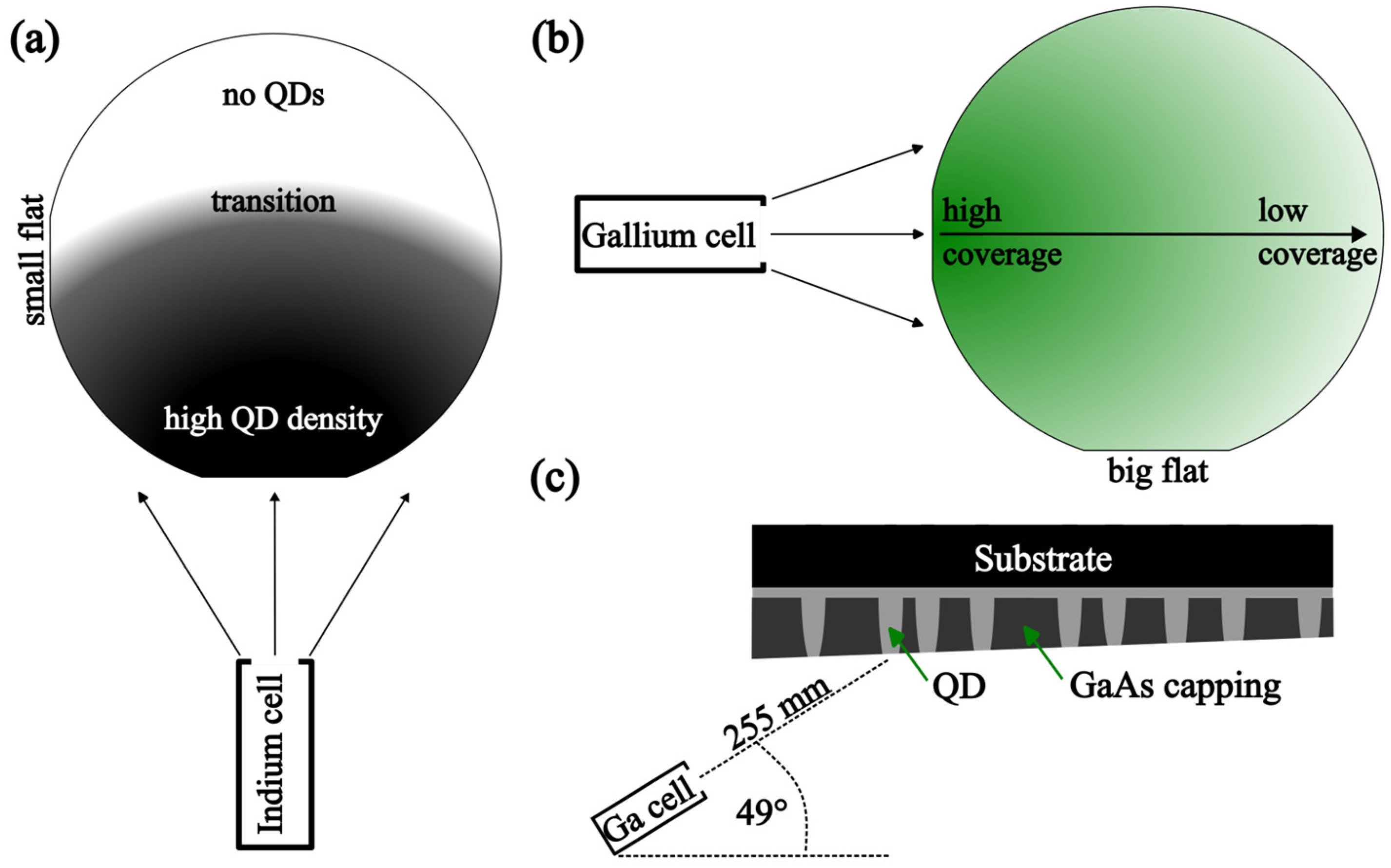
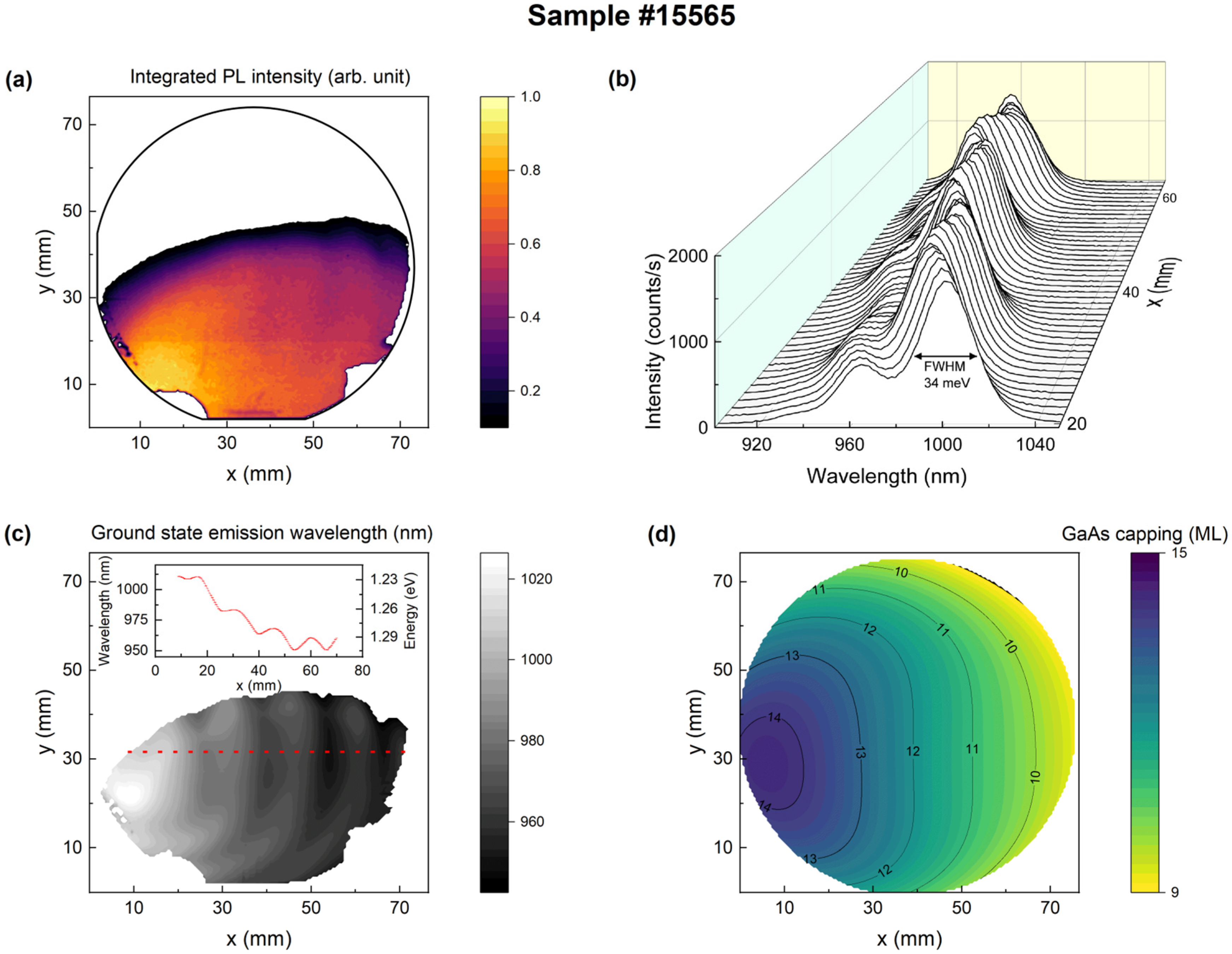
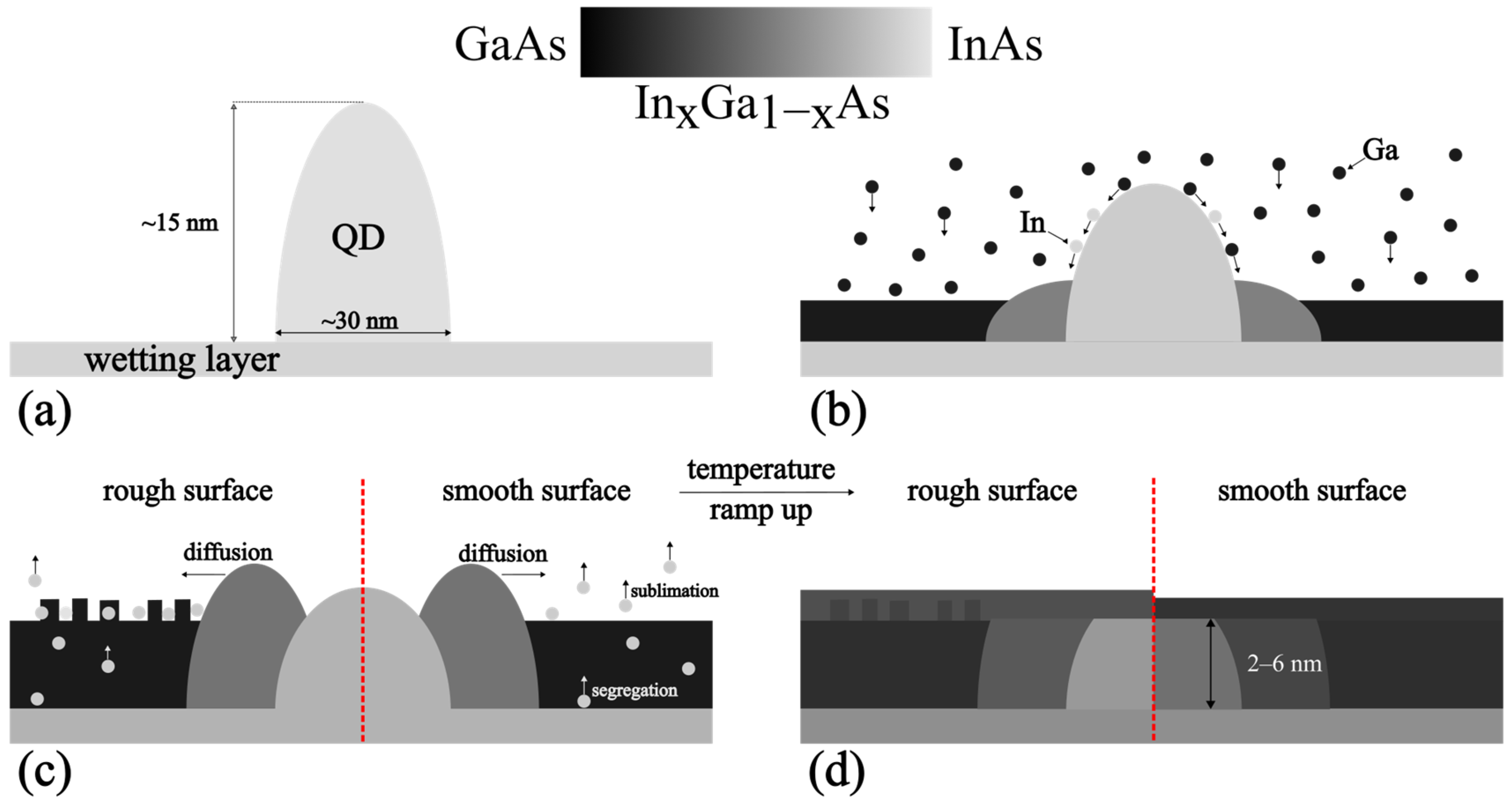
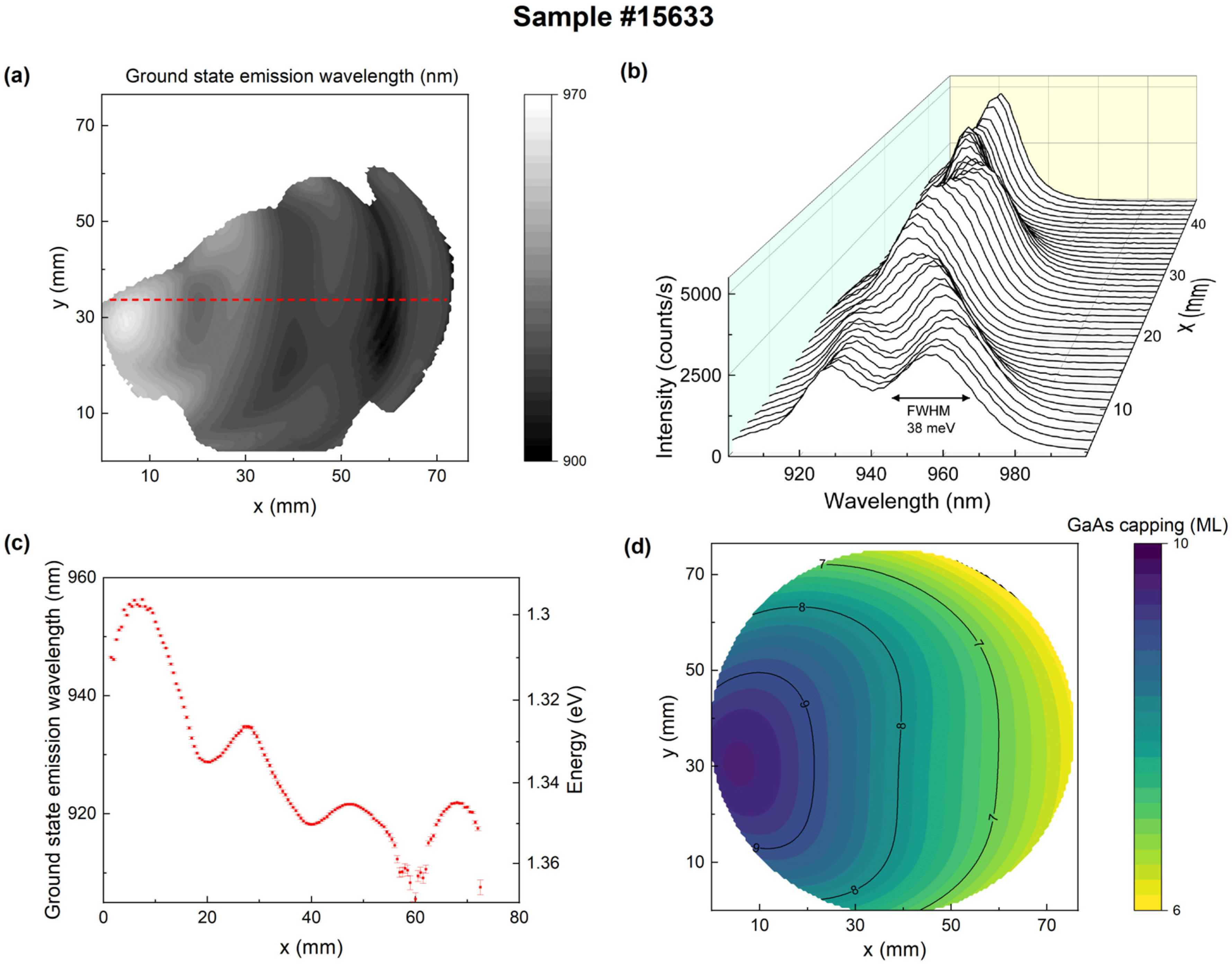
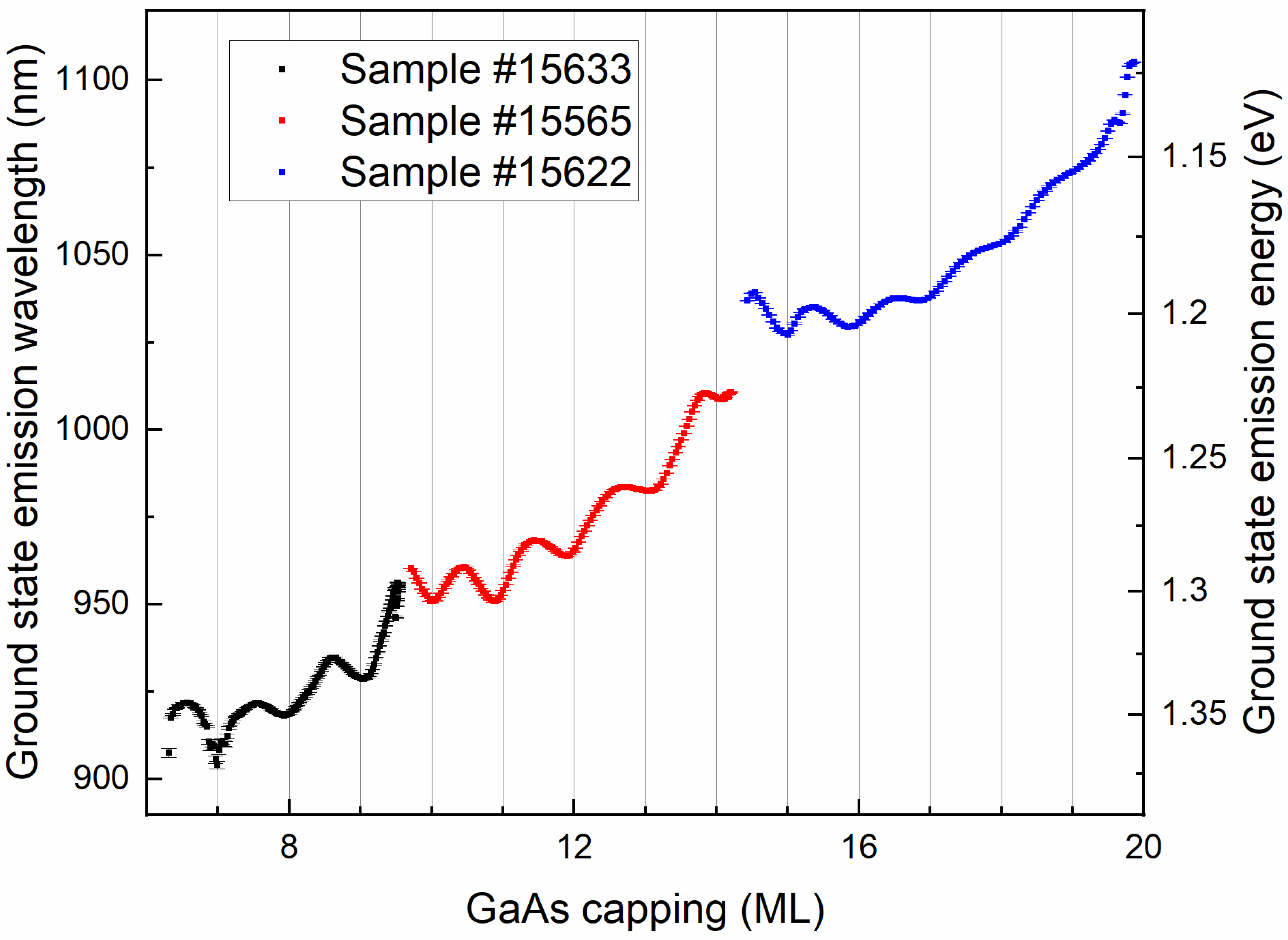
Disclaimer/Publisher’s Note: The statements, opinions and data contained in all publications are solely those of the individual author(s) and contributor(s) and not of MDPI and/or the editor(s). MDPI and/or the editor(s) disclaim responsibility for any injury to people or property resulting from any ideas, methods, instructions or products referred to in the content. |
© 2023 by the authors. Licensee MDPI, Basel, Switzerland. This article is an open access article distributed under the terms and conditions of the Creative Commons Attribution (CC BY) license (https://creativecommons.org/licenses/by/4.0/).
Share and Cite
Spitzer, N.; Bart, N.; Babin, H.-G.; Schmidt, M.; Wieck, A.D.; Ludwig, A. Wafer-Scale Emission Energy Modulation of Indium Flushed Quantum Dots. Crystals 2023, 13, 1657. https://doi.org/10.3390/cryst13121657
Spitzer N, Bart N, Babin H-G, Schmidt M, Wieck AD, Ludwig A. Wafer-Scale Emission Energy Modulation of Indium Flushed Quantum Dots. Crystals. 2023; 13(12):1657. https://doi.org/10.3390/cryst13121657
Chicago/Turabian StyleSpitzer, Nikolai, Nikolai Bart, Hans-Georg Babin, Marcel Schmidt, Andreas D. Wieck, and Arne Ludwig. 2023. "Wafer-Scale Emission Energy Modulation of Indium Flushed Quantum Dots" Crystals 13, no. 12: 1657. https://doi.org/10.3390/cryst13121657




